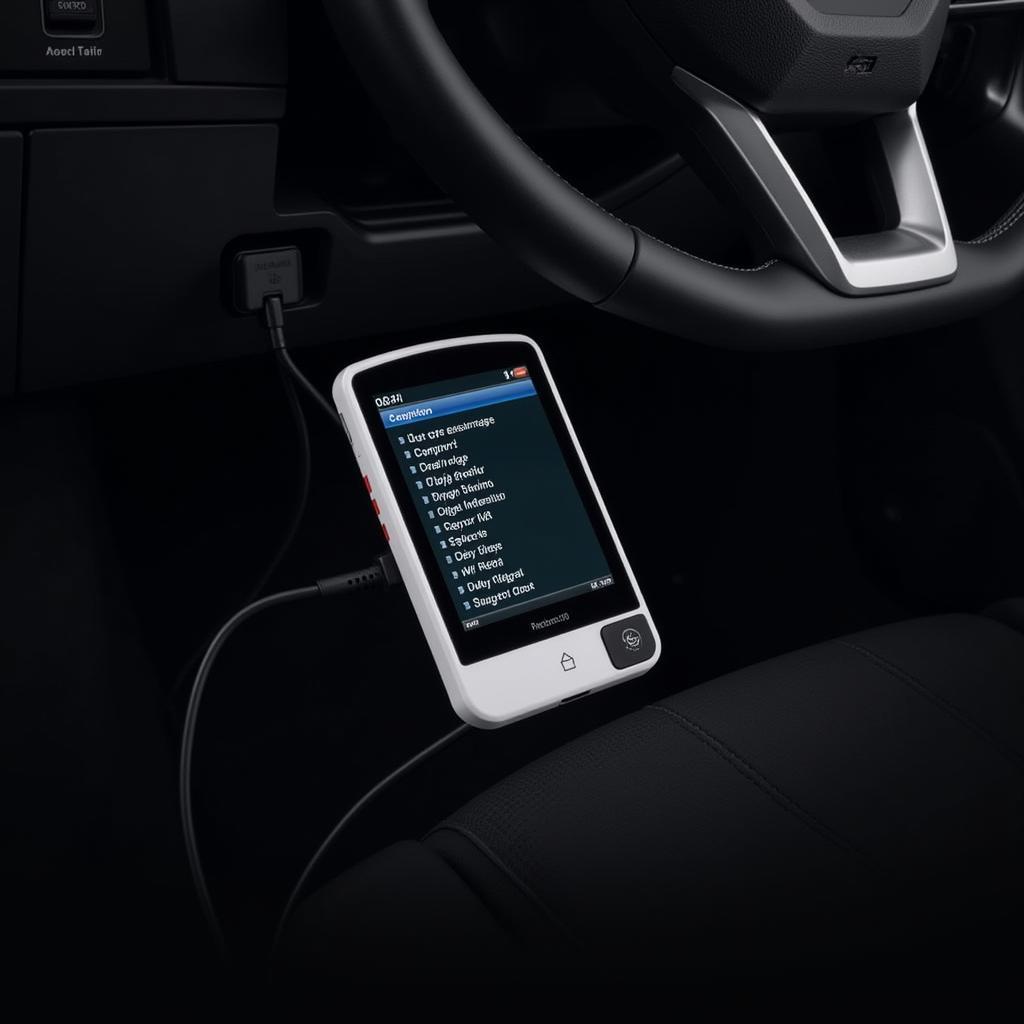A car diagnostic reader, once a tool exclusively for mechanics, is increasingly becoming a must-have for car owners. This handy device can help you understand your car’s health, diagnose problems early, and potentially save you time and money on unnecessary repairs. But how exactly do you use one? This comprehensive guide will walk you through the process, from understanding the basics to interpreting those cryptic codes.
 Car diagnostic reader plugged into a car’s OBD-II port
Car diagnostic reader plugged into a car’s OBD-II port
Understanding Car Diagnostic Readers and OBD-II Ports
Before we dive into the how-to, let’s understand what we’re dealing with. Your car’s computer system constantly monitors various components, storing diagnostic trouble codes (DTCs) when something goes wrong. A car diagnostic reader, also known as an OBD-II scanner, accesses these codes through the OBD-II port, usually located under the dashboard on the driver’s side.
Types of Car Diagnostic Readers
There are various types of car diagnostic readers available, each with different features and price points:
- Basic Code Readers: These affordable readers retrieve and display basic DTCs, often without much explanation.
- Advanced Code Readers: These offer more detailed code descriptions, live data stream viewing, and may even suggest potential fixes.
- Professional Scan Tools: Used by mechanics, these offer comprehensive diagnostics, advanced functions, and access to manufacturer-specific codes.
For most car owners, an advanced code reader strikes a good balance between functionality and affordability.
How to Use a Car Diagnostic Reader: A Step-by-Step Guide
Now, let’s get to the heart of the matter. Here’s a step-by-step guide on How To Use A Car Diagnostic Reader:
- Locate the OBD-II Port: This port is usually under the dashboard on the driver’s side, but its location can vary. Refer to your car’s manual if you can’t find it.
- Turn the Ignition Off: Ensure the engine is off and the key is out of the ignition.
- Connect the Diagnostic Reader: Plug the reader firmly into the OBD-II port. You should hear a click when it’s securely connected.
- Turn the Ignition On: Turn the key to the “on” position but don’t start the engine. This powers up the reader and allows it to communicate with your car’s computer.
- Follow On-Screen Instructions: Most readers will guide you through the process, prompting you to select your car’s make, model, and year.
- Read and Interpret Codes: The reader will display any stored DTCs. Jot them down or take a picture for future reference.
- Research the Codes: Use the reader’s built-in code library or an online resource to understand what each code means.
- Clear the Codes (Optional): Once you’ve addressed the underlying issue, you can use the reader to clear the codes. However, it’s generally recommended to wait until after the repair to prevent accidental deletion of valuable diagnostic information.
Common Car Diagnostic Reader Codes
While countless DTCs exist, here are a few common ones you might encounter:
- P0420: Catalyst System Efficiency Below Threshold (Bank 1): This often indicates a failing catalytic converter, a crucial emissions control component.
- P0301: Cylinder 1 Misfire Detected: This suggests a problem with the ignition system, fuel delivery, or internal engine components related to cylinder 1.
- P0171: System Too Lean (Bank 1): This code means the engine is receiving too much air compared to fuel, often due to a vacuum leak or faulty sensor.
- P0500: Vehicle Speed Sensor Malfunction: This usually points to a faulty speed sensor, which can affect speedometer readings and transmission shifting.
FAQs about Car Diagnostic Readers
Q: Can a car diagnostic reader fix my car?
A: No, a diagnostic reader only diagnoses problems. It doesn’t repair them. However, it provides valuable information that guides repairs.
Q: Do I need a mechanic to use a car diagnostic reader?
A: Basic and advanced code readers are user-friendly and designed for car owners. However, professional scan tools require specialized knowledge.
Q: Can I use a car diagnostic reader on any car?
A: Most modern cars (manufactured after 1996) use the OBD-II standard, making them compatible with most readers.
Conclusion
A car diagnostic reader is an empowering tool for any car owner. By understanding how to use it, you can gain valuable insights into your car’s health, identify potential problems early, and make informed decisions about repairs. While it’s not a substitute for professional mechanic, it’s a valuable asset for anyone who wants to take control of their car maintenance. Remember, regular checks with a car diagnostic reader, combined with routine maintenance, can keep your car running smoothly for miles to come.
If you need help understanding car diagnostic codes or require expert assistance with your vehicle, feel free to reach out to us via WhatsApp at +1(641)206-8880 or email us at [email protected]. Our team of car diagnostic specialists is available 24/7 to assist you. You can also find a wealth of information about how much it costs to put a car on a diagnostic machine and other car diagnostic topics on our website.

Leave a Reply